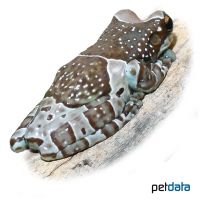Amazonian Milk Frog (Trachycephalus resinifictrix)
| Amazonian Milk Frog Trachycephalus resinifictrix | |
|---|---|
| Name | Amazonian Milk Frog |
| Name Lat. | Trachycephalus resinifictrix |
| Synonym | Phrynohyas resinifictrix |
| Family | Hylids |
| Family lat. | Hylidae |
| Order | Frogs & Toads |
| Order lat. | Anura |
| Origin | South America |
| Habitat | Rainforest |
| Diet | Small live insects |
| Humidity | 70-100 % |
| Behavior | Peaceful, nocturnal |
| Keeping | Pair, group |
| Care Level | Moderate |
| Breeding | Moderately difficult |
| Housing | Treefrog terrarium |
| Life Span | 5 years |
| Protection | No |
| Metric Units | |
| Size | 8 cm |
| Temperature | 24-29 °C |
| Housing Size | 40 x 40 x 60 cm |
| US Units | |
| Size | 3" |
| Temperature | 75-84 °F |
| Housing Size | 15" x 15" x 25" |
Distribution and habitat
The range of the nocturnal tree-hollow toad tree frogs is in the Amazon, extending from eastern Ecuador and Peru through Colombia and Brazil to Suriname and French Guiana, where they inhabit the trees of the tropical rainforest.
Maintenance
For 1-2 animals, the minimum area of the terrarium is 1,600 cm² with a minimum effective height (measured without substrate) of 50 cm. This corresponds to a base area of e.g. 40 x 40 cm. For each additional animal, an additional 500 cm² area and 3 cm height must be provided. The terrarium should be placed in a quiet place without sunlight. You need a terrarium (aquaterrarium) with a substrate of loose, absorbent, not rotting substrate such as sand-peat mixture, coconut fibers or sphagnum moss with a drainage, in addition pieces of bark, flat stones, strongly branched climbing branches, preferably entwined by climbing plants, a dense planting (eg Tradescantia, Ficus, Hoya, bromeliads) and a shallow water basin. Hollow bamboo canes, for example, are suitable as hiding places. Potted plants that can be easily removed for cleaning are advantageous. At least twice a day, except in seasonal dry periods, the inside of the terrarium must be finely sprayed with water (humidity), but a rain or mist system is better
| Temp. day: 24-29 °C | Temp. night: min. 21 °C | Humidity: 70-100 % |
The lighting duration must be 10-14 hours depending on the season. Very suitable are daylight fluorescent tubes with low UV content, supplemented with spotlights.
During the seasonal dry period (3-5 months) the humidity is reduced to 50-80 %.
Diet
The diet consists of live insects such as crickets, small grasshoppers and crickets, as well as mealybug larvae and cockroaches. After a period of habituation (feeding with tweezers), special ready-made food for insectivores is often accepted as well. Food should be offered to adult animals 2-3 times a week, young animals must be fed daily. It is important to add minerals and vitamins regularly (e.g. by dusting the feed animals). The quality of the feed animals can be upgraded by feeding overripe fruit and honey water.
A varied diet promotes health and prevents deficiency symptoms.
Reproduction and breeding
Both sexes have a dark brown base coloration with white spots. Males have large sound bladders and can produce loud sounds.
A dry period is necessary to stimulate reproduction. Then the female, ready to spawn, is taken in the mating grip (amplexus) by the male and she lays up to 4000 eggs in water-filled tree stumps. At 25 °C the larvae (tadpoles) hatch after only one day and are fed with nourishing eggs by the female. After 4-6 weeks the transformation (metamorphosis) is completed and the young frogs, about 2 cm in size, leave the water.
Their life expectancy can be over 5 years.
Important
Tree-hollow toad treefrogs have glandular warts on their backs that secrete a sticky skin secretion used to ward off predators.
Before purchasing, a terrarium should be prepared that meets the species specific needs. Good ventilation without drafts is necessary, as well as equipment for measuring temperature and humidity. The lighting has to correspond to the species-specific day-night rhythm and should be placed in such a way that the animals cannot injure themselves. The terrarium should be locked in such a way that neither unauthorized persons can open it nor the animals can escape. Special attention must be paid to thorough hygiene and impurities must be removed regularly
Further literature can be found in your pet store.
References
Text: Serena Werle; Image: petdata
Source: VDA & DGHT (2006): Haltungsrichtlinien für die Haltung von Anuren; ENGELMANN (2006): Zootierhaltung - Tiere in menschlicher Obhut: Reptilien und Amphibien, Harri Deutsch Verlag
- Gemäß § 21 Abs. 5 Tierschutzgesetz idgF
